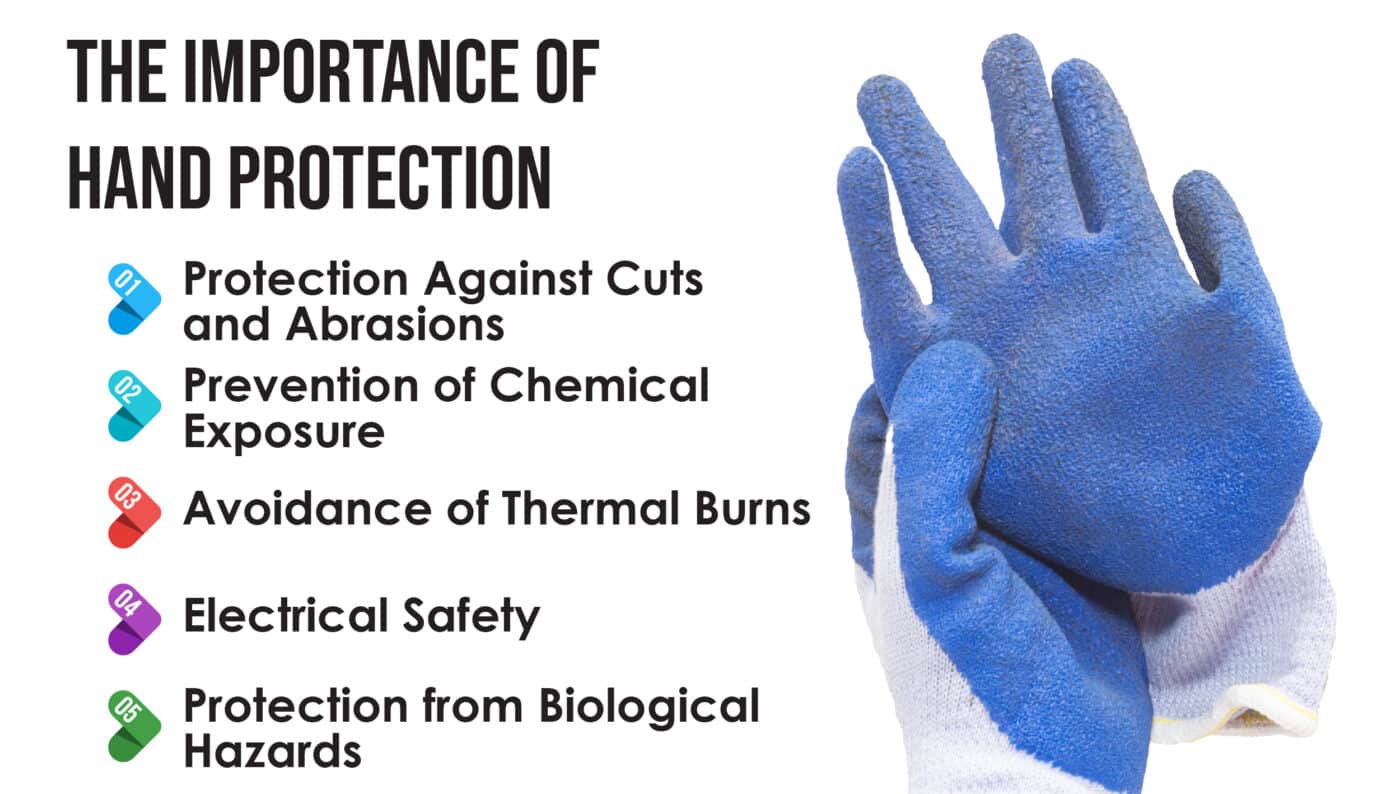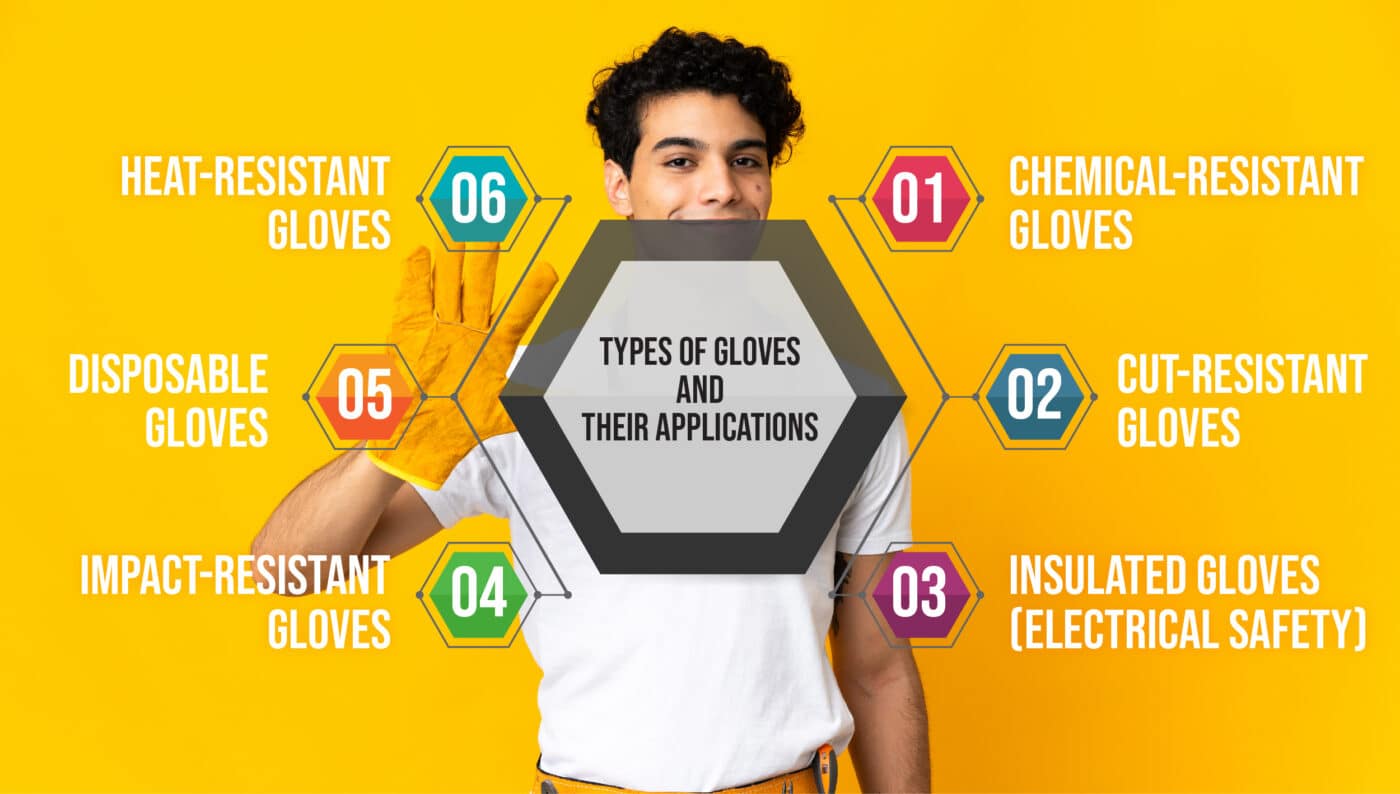Safety Knowledge
Glove Selection and Hand Protection in the Workplace
Introduction: Hands are one of the most vital and vulnerable parts of the human body when it comes to workplace injuries. Whether it’s handling hazardous chemicals, operating heavy machinery, or working with sharp tools, employees’ hands are constantly exposed to risks. Gloves are the most common form of personal protective equipment (PPE) used to protect hands from these workplace hazards. Proper glove selection and use are essential to ensuring the safety and well-being of workers, reducing the risk of injuries such as cuts, burns, chemical exposures, and infections.
This month’s EHS (Environmental, Health, and Safety) topic focuses on the importance of glove selection and hand protection in the workplace. Understanding the various types of gloves available, knowing how to choose the right glove for specific tasks, and implementing proper training and maintenance procedures can significantly improve workplace safety.

The Importance of Hand Protection
Hand injuries are among the most common types of workplace injuries, often leading to lost workdays, permanent disabilities, and high medical costs. According to the U.S. Bureau of Labor Statistics, over a million hand injuries occur every year in the workplace, with many of these injuries requiring medical treatment or resulting in long-term health consequences.
Hand protection is crucial because:
- Protection Against Cuts and Abrasions: Workers in industries such as construction, manufacturing, and food processing are at risk of cuts, scrapes, and abrasions from sharp tools, machinery, or materials.
- Prevention of Chemical Exposure: Chemical handling jobs, such as in laboratories or cleaning operations, pose a risk of burns, irritation, or systemic toxicity from skin contact with hazardous substances.
- Avoidance of Thermal Burns: Workers in industries involving hot materials or open flames, like welding or food processing, are at risk of thermal burns if their hands are not properly protected.
- Protection from Biological Hazards: Healthcare, janitorial, and agricultural workers may be exposed to infectious agents or bacteria, making hand protection vital to avoid contamination or disease transmission.
- Electrical Safety: Electrical workers need insulated gloves to prevent electric shock when working on live circuits.
Given these risks, it’s essential to choose the right gloves based on the specific hazards present in the workplace.

Types of Gloves and Their Applications
There are many types of gloves available, each designed to protect against specific hazards. Here are some of the most common glove types and their uses:
1. Cut-Resistant Gloves
Cut-resistant gloves are made from materials like Kevlar, stainless steel mesh, or high-performance fibers. They are designed to protect against cuts and abrasions from sharp objects like knives, glass, and metal.
- Applications: Manufacturing, food processing, glass handling, and construction.
- Considerations: Look for gloves with an appropriate cut-resistant rating (e.g., ANSI/ISEA 105 standard) based on the risk level in the workplace.
2. Chemical-Resistant Gloves
Chemical-resistant gloves are made from materials like rubber, nitrile, neoprene, or PVC, designed to provide a barrier against a wide range of chemicals. Different materials offer protection against different chemicals, so it’s important to choose gloves that are compatible with the specific chemicals being handled.
- Applications: Laboratories, cleaning, oil and gas industries, and agriculture.
- Considerations: Select gloves based on the type of chemical exposure and the material compatibility. Always check the manufacturer’s guidelines for chemical resistance.
3. Heat-Resistant Gloves
Heat-resistant gloves are made from materials like leather, aluminized fabrics, or synthetic fibers designed to withstand high temperatures. These gloves are critical for workers handling hot objects or working near open flames.
- Applications: Welding, metalworking, foundries, and cooking or food preparation.
- Considerations: Choose gloves rated for the specific temperature range and type of thermal hazard.
4. Impact-Resistant Gloves
Impact-resistant gloves are designed to protect against blunt force trauma and crushing injuries. They are typically made with padding or hard materials like gel inserts or thermoplastic rubber (TPR) on the back of the hand.
- Applications: Construction, demolition, heavy machinery operation, and logistics.
- Considerations: Look for gloves that offer both impact protection and dexterity for tasks requiring fine motor skills.
5. Insulated Gloves (Electrical Safety)
Insulated gloves are specifically designed for electrical workers to prevent electrical shock. Made from rubber or rubber-lined materials, these gloves provide insulation to protect workers from live electrical circuits.
- Applications: Electrical work, utility maintenance, and industrial environments.
- Considerations: Choose gloves that meet the relevant electrical standards, such as ASTM D120, for high-voltage protection.
6. Disposable Gloves
Disposable gloves, typically made from nitrile, latex, or vinyl, are commonly used in environments where frequent glove changes are necessary. They are lightweight, provide minimal protection, and are designed for one-time use.
- Applications: Healthcare, food handling, janitorial work, and laboratory settings.
- Considerations: Ensure the gloves are compatible with the chemicals or substances being handled. For workers with latex allergies, nitrile gloves are an excellent alternative.
Factors to Consider When Selecting Gloves
The proper selection of gloves depends on various factors, and the choice should be made carefully to ensure maximum protection and comfort. Key factors to consider include:
- Nature of the Hazard: Identify the primary hazard (e.g., cuts, chemicals, heat, impact) and choose gloves designed to protect against that specific risk.
- Glove Material: The material should be compatible with the type of exposure. For example, nitrile gloves are suitable for chemical resistance, while leather gloves provide excellent abrasion protection.
- Fit and Comfort: Proper fit is critical. Gloves that are too tight can restrict movement, while those that are too loose can cause accidents. Gloves should be flexible, breathable, and comfortable for the worker to wear for extended periods.
- Dexterity and Sensitivity: Consider tasks requiring fine motor skills. For precision work, gloves should offer tactile sensitivity without compromising protection.
- Durability and Maintenance: Choose gloves that can withstand the conditions of the workplace. Some gloves may require regular inspection or maintenance, while others, like disposable gloves, may need frequent replacement.
- Cost: While higher-quality gloves may come at a higher initial cost, their durability and ability to prevent injuries can save money in the long run by reducing healthcare and insurance costs.
Proper Use and Maintenance of Gloves
To ensure the longevity and effectiveness of gloves, workers must follow proper maintenance protocols:
- Inspection: Gloves should be inspected regularly for signs of wear and tear, such as punctures, holes, or degradation. Damaged gloves should be replaced immediately.
- Cleaning: Some gloves, like those used in chemical or food handling, may need to be cleaned between uses. Follow the manufacturer’s cleaning guidelines to avoid damaging the material.
- Storage: Gloves should be stored in a clean, dry place to prevent deterioration. Gloves should be kept away from extreme temperatures, chemicals, or direct sunlight.
- Training: Workers should be trained on the correct use, fitting, and maintenance of gloves. This includes understanding when to replace gloves and how to dispose of them properly.
Conclusion
Glove selection and hand protection are vital components of workplace safety programs. Properly selected and maintained gloves can prevent a wide range of injuries, including cuts, burns, chemical exposures, and electrical accidents. By understanding the types of gloves available, choosing the appropriate glove for each task, and ensuring proper use and maintenance, employers can protect their workers from hand injuries and promote a safer working environment. Effective hand protection not only reduces the risk of accidents but also enhances overall productivity and morale in the workplace.
